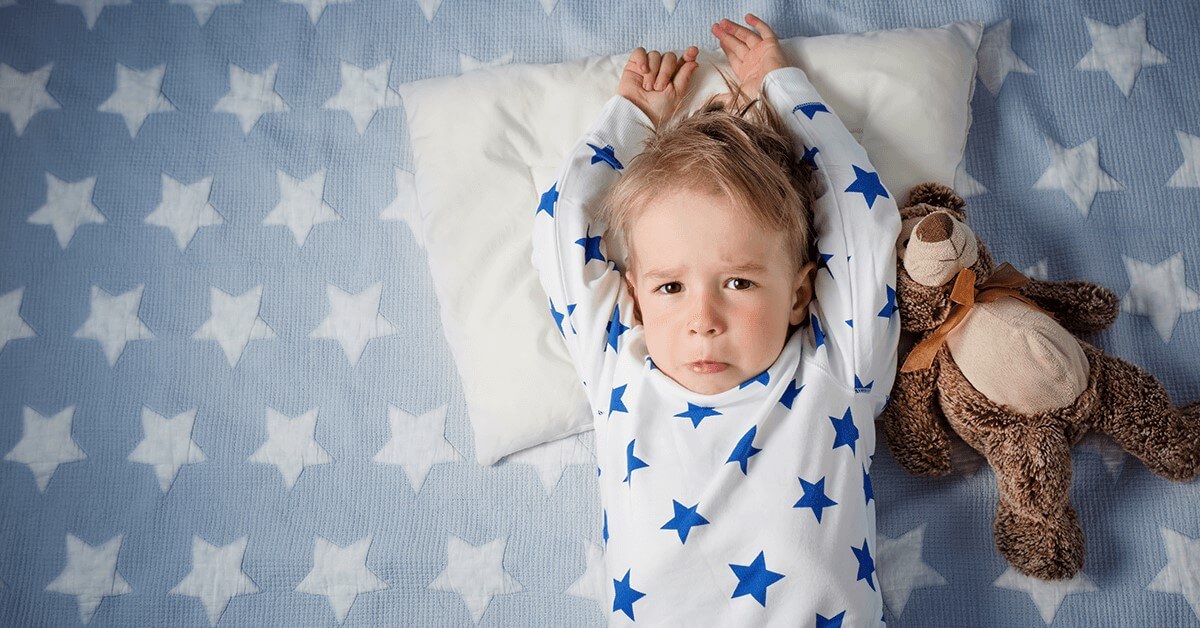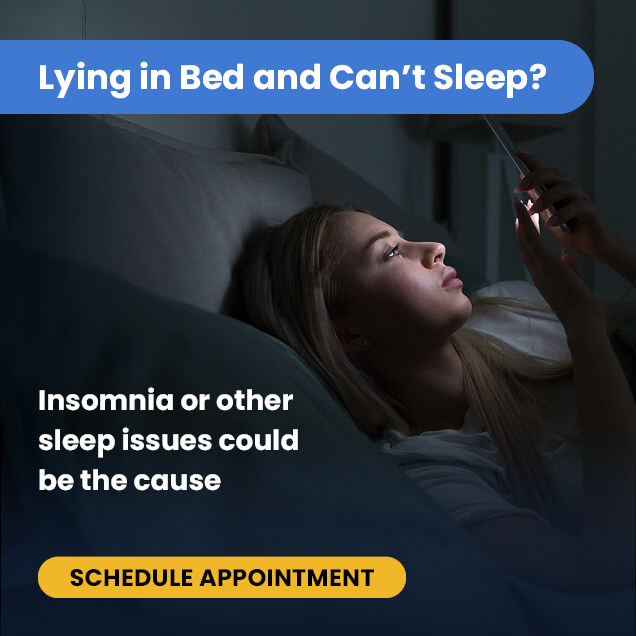Use the player to listen to the article and/or continue to read below.
Types of Pediatric Insomnia
|
Risk Factors
|
Complications
|
Epidemiology
|
Diagnosis
|
Treatment
Introduction
Many parents deal with bedtime defiance and nighttime awakenings from their kids from time to time; however, chronic sleeplessness can lead to behavioral problems, poor academic performance, and chronic health conditions.[1]
Pediatric insomnia can be classified as behavioral, psychophysiological (conditioned), or transient (short-term). The persistence of symptoms for more than 3 nights a week, for longer than 3 months, warrants a trip to the pediatrician.
Continue reading to learn more about what behaviors can affect your child’s sleep patterns, when your child’s sleep habits are signs of a larger problem, and steps you can take to improve their sleep.
Types of Pediatric Insomnia
1) Behavioral Insomnia
Behavioral Insomnia is characterized by refusal to go to bed, delayed bedtimes, and frequent awakenings throughout the night that occur at least 3 nights or more, for a minimum of 3 months.
A child’s behavioral insomnia can stem from problematic bedtime techniques used by parents to get their kids to sleep (sleep-onset insomnia), an inability to establish bedtime rules and rituals (limit-setting insomnia), or both situations may be present.
Sleep-onset insomnia is characterized by a child learning to fall asleep under specific conditions, like having a back rub or being rocked. If roused from sleep, the child may not be able to fall back asleep without being soothed by a parent.
Limit-setting insomnia is characterized by a child resisting bedtime through arguing, making repeated requests as a stall tactic, and being defiantly oppositional. As a result, your child may be sleep deprived due to inadequate sleep.
2) Psychophysiological Insomnia
Psychophysiological insomnia (conditioned) typically affects older kids and teenagers and stems from the anxiety associated with falling or staying asleep.
The psychological and physiological response to the anxiety compounds over time, exasperating symptoms of sleeplessness. Over time the bedroom is associated with wakefulness, making it increasingly difficult to relax and get to sleep.
3) Transient Sleep Disturbances
Transient sleep disturbances
are characterized by short-term insomnia due to a life event or sudden stressors,
like the death of a family pet or a move to a new house. This type of sleeplessness usually wanes over time,
with normal sleep patterns returning without the need for a doctor’s visit.
Risk Factors
There are factors that increase the likelihood that a child will experience chronic sleeplessness, which can be divided into two categories: intrinsic and extrinsic. Often, sleeplessness can be the result of a combination of both factors.
One study of 16-month-old twins found that approximately 26% of affected sleep duration was due to genetics, while 66% was due to environmental factors.[2]
Intrinsic Factors
Some biological traits, including conditions present at birth, are known to cause sleeping difficulties in children. These factors include your child’s chronotype, underlying health conditions, such as anxiety disorders, medical conditions, such as asthma, or neurological disorders, such as autism spectrum disorders.[3]
Extrinsic Factors
Extrinsic factors include the child’s environment and how they are parented,
specifically concerning bedtime processes. It’s common for parents to incorporate short-term tactics,
like back rubbing or extending bedtimes,
for a quick fix but these actions can lead to bigger sleep issues for the child.
Complications of Poor Sleep
Epidemiology
An estimated 20-30% of children have severe sleep problems. Different factors affect children differently depending on their age. For example, teenagers are more likely to experience or have a history of psychiatric disorders that cause sleep problems.
Preschool Children and Younger
Nearly 20% of preschool-aged children show some symptoms of insomnia.[4]
School-Aged Children
Between 20% and 40% have shown symptoms of insomnia, with a higher frequency of symptoms presenting in girls than boys.[5]
Teenagers
Nearly 11% of teenagers have a history of insomnia.[6]
Diagnosing Insomnia in Children
Before diagnosing insomnia, a doctor will gather information about your child’s health and home life to determine the key factors causing his or her sleeping difficulties. There’s a specific questionnaire for pediatric insomnia called B.E.A.R: Bedtime Issues, Excessive Daytime Sleepiness, Night Awakenings, Regularity and duration of sleep.
Questioning revolves around your child’s sleep habits, such as any problems he or she has falling or staying asleep, your child’s sleep routines, or how tired your child may seem during the day.
Your child’s doctor may also request information about the environment in which your child’s sleep problems occur, including how you respond to certain behaviors and any other factors that may affect your child’s sleep habits.
For example,
you may be asked to keep a
sleep diary
to help the doctor understand your child’s sleep habits over time.
Treating Children with Insomnia
1) Behavioral Therapy
Because behaviors are such a common cause of childhood insomnia, addressing the actual behaviors themselves is the primary treatment method recommended by doctors.
In fact, research suggests that behavioral interventions can safely and effectively change your child’s sleep habits.[7] Some types of effective behavioral interventions include the following tactics.
2) Systematic Ignoring
Systematic ignoring is the act of ignoring a child’s behavior to make it go away. When your child cries at night, and you ignore them in the hopes they will self-soothe, you’re engaging in behavior with the intention of my making your child less reliant on you for sleep.
While some parents may worry that this approach can stress a child out or cause harm, research suggests that ignoring behaviors helps change sleep behaviors and cause no negative stress reactions in children.[8]
There are two varying degrees of systematic ignoring: unmodified extinction and graduated extinction.
Unmodified extinction is a type of systematic ignoring where you put your child to bed and ignore them until morning. While research suggests this approach can be very effective, it’s not always easy to maintain for families. The sound of a child crying constantly can be difficult to ignore.
Graduated extinction is the process of slowly weaning your child off needing help to fall asleep. For example, waiting longer and longer each night before checking on your child can help them learn to fall asleep without your help. When checking on your child, it’s important to keep interactions short (such as a quick pat on the back) and focus on building his or her independence.
3) Bedtime Fading
Fading, an approach also found effective by research, means delaying a child’s time in bed with the goal of changing his or her internal clock. This approach can also involve ensuring your child spends less time in his or her bed before falling asleep, which may seem gentler than extinction behavior.
4) Routines & Sleep Hygiene
Setting routines for a child can help ensure that your child gets the proper age-appropriate amount of sleep. In addition, healthy sleep hygiene practices can help prepare your child for bed hours beforehand and include relaxing activities, like taking a hot bath or reading a book.
5) Strategic Napping
You should be mindful of when and how long your child naps. Napping for too long, or napping too close to bedtime, can make it challenging to put your child down to sleep at night. Children need at least 4 hours between periods of sleep to make sure they are tired enough for their next sleep period.
6) Positive Reinforcement
Positive reinforcement involves rewarding your child when they meet certain goals, such as sleeping in their own bed for an entire night.
7) Medication
Certain medications, such as antihistamines, melatonin, and prescription sleep medications, can be prescribed for acute insomnia, but only in addition to behavioral therapy.[9]
If your child has an underlying health condition affecting his or her sleep, your child’s doctor may choose to treat that condition first with medication (if needed); however, research suggests that behavioral therapy should be the first-line treatment for insomnia, particularly in younger children.[9]
Conclusion
Insomnia can take a toll on the child, you as the parent, and the rest of your family. If you are ever concerned about your child’s sleep habits, or you think he or she may be experiencing insomnia, talk to your child’s doctor to find a treatment plan that fits his or her needs.
References:
- Combs, D., Goodwin, J. L., Quan, S. F., Morgan, W. J., Shetty, S., & Parthasarathy, S. (2016). Insomnia, Health-Related Quality of Life and Health Outcomes in Children: A Seven Year Longitudinal Cohort. Scientific reports, 6, 27921. https: //doi.org/10.1038/srep27921
- Fisher, A., van Jaarsveld, C. H., Llewellyn, C. H., & Wardle, J. (2012). Genetic and environmental influences on infant sleep. Pediatrics, 129(6), 1091–1096. https://doi.org/10.1542/peds.2011-1571
- Sheldon SH, Chervin, RD, Eichler, AF. Medical disorders resulting in problem sleeplessness in children. Up To Date, 1-50. https//www.uptodate.com/contents/medical-disorders-resulting-in-problem-sleeplessness-in-children
- Singareddy, R., Moole, S., Calhoun, S., Vocalan, P., Tsaoussoglou, M., Vgontzas, A. N., & Bixler, E. O. (2009). Medical complaints are more common in young school-aged children with parent reported insomnia symptoms. Journal of clinical sleep medicine : JCSM : official publication of the American Academy of Sleep Medicine, 5(6), 549–553.
- Fricke-Oerkermann, L., Plück, J., Schredl, M., Heinz, K., Mitschke, A., Wiater, A., & Lehmkuhl, G. (2007). Prevalence and course of sleep problems in childhood. Sleep, 30(10), 1371–1377. https://doi.org/10.1093/sleep/30.10.1371
- Johnson, E. O., Roth, T., Schultz, L., & Breslau, N. (2006). Epidemiology of DSM-IV insomnia in adolescence: lifetime prevalence, chronicity, and an emergent gender difference. Pediatrics, 117(2), e247–e256. https://doi.org/10.1542/peds.2004-2629
- Mindell, J. A., Kuhn, B., Lewin, D. S., Meltzer, L. J., Sadeh, A., & American Academy of Sleep Medicine (2006). Behavioral treatment of bedtime problems and night wakings in infants and young children. Sleep, 29(10), 1263–1276.
- Gradisar M, Jackson K, Spurrier NJ, et al. Behavioral Interventions for Infant Sleep Problems: A Randomized Controlled Trial. Pediatrics 2016; 137. https://doi.org/10.1093/sleep/29.10.1263
- Owens, J. A., Babcock, D., Blumer, J., Chervin, R., Ferber, R., Goetting, M., Glaze, D., Ivanenko, A., Mindell, J., Rappley, M., Rosen, C., & Sheldon, S. (2005). The use of pharmacotherapy in the treatment of pediatric insomnia in primary care: rational approaches. A consensus meeting summary. Journal of clinical sleep medicine : JCSM : official publication of the American Academy of Sleep Medicine, 1(1), 49–59.






